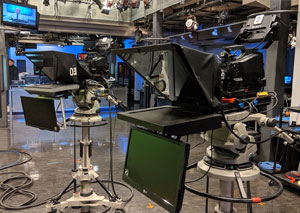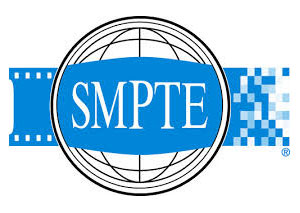 CTV Vancouver Island’s studios in Victoria, BC recently went through a complete 16:9 SD to full HD upgrade. The upgrade – after broadcasting in SD for 18 years – included re-wiring the entire station and replacing the control room switcher and studio cameras. The systems integration was performed internally by the Bell Media integration group. Three new Sony HXC-FB80 HD studio cameras, along with HXCU-FB80 CCU units and HZC-RCP5 camera remote control software were selected as the main studio pedestal cameras. Two cameras sit on Vinten pedestals and are equipped with Canon wide angle lenses. The cameras are used for CTV’s 5 p.m., 6 p.m., and 11 p.m. newscasts. Thanks to the HZC-RCP5 software, the HXC-FB80’s can be controlled from remote locales as well as the local control room, which means the video supervisor for CTV nationally can digitally shade and color the cameras from CTV headquarters in Toronto. Optical filter wheels for neutral density and color correction can also be controlled using the application. The cameras at CTV Vancouver Island can also be controlled using the HZC-RCP5 camera control software running on a computer at the station. This enables the on-site technical director to control various camera pre-sets based on a specific set or shot and have access to all the shading and recalls.
CTV Vancouver Island’s studios in Victoria, BC recently went through a complete 16:9 SD to full HD upgrade. The upgrade – after broadcasting in SD for 18 years – included re-wiring the entire station and replacing the control room switcher and studio cameras. The systems integration was performed internally by the Bell Media integration group. Three new Sony HXC-FB80 HD studio cameras, along with HXCU-FB80 CCU units and HZC-RCP5 camera remote control software were selected as the main studio pedestal cameras. Two cameras sit on Vinten pedestals and are equipped with Canon wide angle lenses. The cameras are used for CTV’s 5 p.m., 6 p.m., and 11 p.m. newscasts. Thanks to the HZC-RCP5 software, the HXC-FB80’s can be controlled from remote locales as well as the local control room, which means the video supervisor for CTV nationally can digitally shade and color the cameras from CTV headquarters in Toronto. Optical filter wheels for neutral density and color correction can also be controlled using the application. The cameras at CTV Vancouver Island can also be controlled using the HZC-RCP5 camera control software running on a computer at the station. This enables the on-site technical director to control various camera pre-sets based on a specific set or shot and have access to all the shading and recalls.
 SMPTE 2019 saw NASA and Amazon Web Services (AWS) successfully test a workflow marking the first use of cloud resources for data storage and video origination for streaming from space. The proof of concept expands on the workflow NASA and AWS co-produced in 2017 to enable the first-ever live 4K UHD stream from space, and now includes cloud-based media services for high-quality and secure live video transport, video origination and packaging, broadcast-grade live video processing, and content delivery networks. The test took place during a special SMPTE program honoring the 50th anniversary of the Apollo 11 moon landing and supported a live interview with astronauts Christina Koch, Jessica Meir, and Andrew Morgan aboard the International Space Station, along with two NASA colleagues presenting at SMPTE 2019 in Los Angeles. NASA is seeking innovative ways to reduce the cost and complexity of live streaming from space as it prepares to send the first woman and next man to the lunar face by 2024 through its Artemis architecture. By shifting 90% of the workload into the cloud instead of using traditional ground-based broadcast video processing, satellite long-haul transport, and content delivery infrastructures, the workflow helps reduce the cost and complexity of streaming video from space to scientists and viewers on Earth. Broadcast on NASA TV and streamed online, the interview is available on both platforms for on-demand viewing.
SMPTE 2019 saw NASA and Amazon Web Services (AWS) successfully test a workflow marking the first use of cloud resources for data storage and video origination for streaming from space. The proof of concept expands on the workflow NASA and AWS co-produced in 2017 to enable the first-ever live 4K UHD stream from space, and now includes cloud-based media services for high-quality and secure live video transport, video origination and packaging, broadcast-grade live video processing, and content delivery networks. The test took place during a special SMPTE program honoring the 50th anniversary of the Apollo 11 moon landing and supported a live interview with astronauts Christina Koch, Jessica Meir, and Andrew Morgan aboard the International Space Station, along with two NASA colleagues presenting at SMPTE 2019 in Los Angeles. NASA is seeking innovative ways to reduce the cost and complexity of live streaming from space as it prepares to send the first woman and next man to the lunar face by 2024 through its Artemis architecture. By shifting 90% of the workload into the cloud instead of using traditional ground-based broadcast video processing, satellite long-haul transport, and content delivery infrastructures, the workflow helps reduce the cost and complexity of streaming video from space to scientists and viewers on Earth. Broadcast on NASA TV and streamed online, the interview is available on both platforms for on-demand viewing.
Subscribe Now – Free!
Broadcast Dialogue has been required reading in the Canadian broadcast media for 25 years. When you subscribe, you join a community of connected professionals from media and broadcast related sectors from across the country.
The Weekly Briefing from Broadcast Dialogue is delivered exclusively to subscribers by email every Thursday. It’s your link to critical industry news, timely people moves, and excellent career advancement opportunities.
Let’s get started right now.



